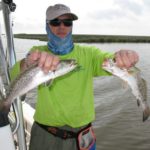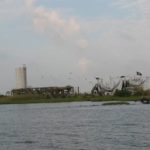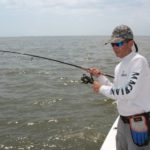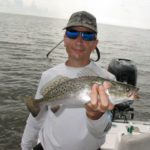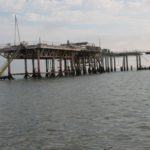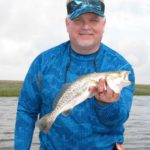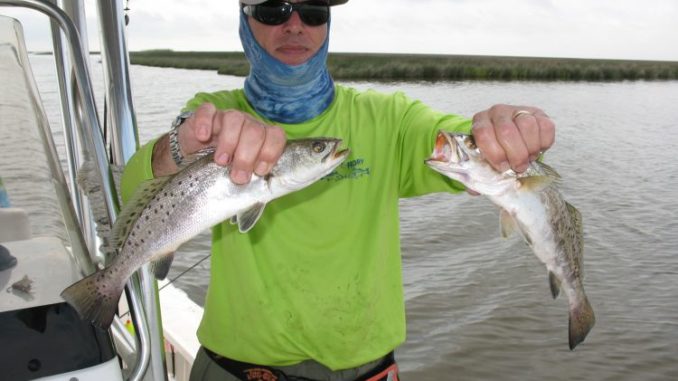
The trout action in this huge Southeast Louisiana bay heats up, but things have changed over the years. This guide teaches you how to find specks under the new normal conditions.
Black Friday, the day after Thanksgiving Day, is probably the best-known shopping day of the year. Stores everywhere advertise their merchandise at sharp discounts and anxious shoppers sometimes camp out overnight in front of their favorite store to be sure they don’t miss the bargains.
Interestingly, Black Friday got its somewhat ominous-sounding name from retailers themselves, who said after 10 months of lackluster sales and a bottom line in the red that this was the day they’d finally start making a profit and get back in the black.
Here in Southeast Louisiana, many of us anglers feel the same way — not about shopping but about fishing.
We look forward to a day on the water with all the anticipation of a Black Friday shopper. And, for those of us who love to hunt trout in Black Bay, this is the month to get back in the Black.
For decades, Black Bay anglers planned their trips for July, when the action from Stone to Battledore and all points between normally got red hot.
But few things are normal anymore when it comes to fishing that area. Erosion has taken a terrible toll on the marshes, and hurricanes Katrina, Rita and Isaac sent the normal rate of erosion into hyper-drive.
Then last year at this time the river was exceptionally high, reaching 14.5 feet at the Carrollton gauge on July 18 — and it was still registering above 10 feet by the end of the month.
The high water combined with last year’s persistent and blustery west winds made Black Bay a muddy mess almost the entire summer, ruining many a fishing plan. I know that every time I tried to fish that way I wound up turning back because of muddy conditions.
But this year should be different.
The river should move well below the magic 10-foot mark on the gauge in June and, as we ease into July and the heat of summer, the river drops even more, allowing green Gulf water to bring its higher salinity and hungry trout back to their usual Black Bay haunts.
I was itching to get out there, so I called Capt. Rory Rorison of United Charters (504-439-1680) to see if I could persuade him to take me.
Rorison was ready and willing to go but a recent mishap forced him to temporarily lay up his big boat for some quick repairs. He was the second guide I spoke to in as many months who had hit a submerged object in heavily traveled waterways and damaged their lower units — and, in this case, the hull, too.
Such things remind me that we should always boat with caution, and to remember to wear a life jacket when running.
Undeterred, I asked Rorison to pilot my boat and take me and a couple friends — Kevin Bergeron and John Herman — to Black Bay to catch some fish. So we loaded up the baitwell with live shrimp at Campo’s Marina and made the run.
The captain said short runs are over for the season, so if you want to get on a good trout bite you have to make the longer hauls to the outside lakes and bays.
Our first stop was Stone Island. Or what was left of it.
If you haven’t fished it since Katrina and Isaac, you wouldn’t recognize it. Basically it’s mostly gone.
The big radio tower — gone. The island itself is a fraction of its former size and divided almost in half, with a row of mostly submerged rocks stretching between the two sections.
I suspect those rocks will vanish during higher tides and lurk just below the surface to ambush unwary boaters. Note to self: Don’t try to pass between the sections of Stone Island.
But the rocks that prevent passage do provide forage and cover for ravenous trout and redfish, and Rorison pulled slowly to within casting range before employing the Power-Pole to hold us in place.
“Live shrimp under a cork,” Rory said loud enough for us all to hear, and four corks whistled out in all directions.
I figured the trout and reds would be near the rocks, so that’s where I threw — and instantly snagged bottom. First cast and I lost my line, cork and all.
Before I could re-tie somebody else did the same thing. Note to self: Don’t fish too close to those rocks.
We gave the spot plenty of time to produce, and probably stayed there a bit longer than the sparse action justified. But the spot looked so good and it’s a known producer of good fish, so we sat and worked it more than thoroughly — and even then pulled away reluctantly.
Rorison had already said the water was not pretty out here, which was really an understatement. The water was dirty looking, and we noticed around the line of pilings (another good place to pick up reds and trout at Stone Island) that the water was just as ugly.
“Part of the new normal out here in Black Bay is the pervasive presence of river water,” the guide explained. “There are so many cuts in the levees now that the water just comes through to the east side unrestricted.
“And now any west wind pushes it over in this direction.”
We did put a few nice trout in the box at Stone Island, but the morning was still young and so many other places were calling.
“You have a lot of options out here,” Rorison said. “When I make the run this way, I like to start the morning fishing shallower water around shorelines, over reefs or around islands. I always look for clean water, moving current and any sign of bait in the water. The fish tend to start out in shallower water in the mornings, but they move to deeper water as the sun gets up, and that happens quickly in July.”
He said there are really just a couple of choices left to fish visible islands, although that doesn’t mean you shouldn’t try out the old locations.
“Stone Island and Belle Island are the only two left out here of any significant size, and there’s really not much left of them,” Rorison said. “Pelican (Island) is pretty much gone; Lonesome is gone, as are a half dozen others.
“But if you have the coordinates you can still fish over the underwater structure. There’s still a lot of bottom structure and submerged reef that holds fish. We hauled a bunch of pretty trout off of Lonesome Island, but when you fish it you are sitting in wide-open water.”
Rorison said live shrimp and croakers are the best baits from now through the summer. They should be fished either under a cork or on the bottom.
“I’m not saying you won’t catch anything on plastic, but you always do better on live bait,” he said.
After the shallow bite crashes for the day, it’s time to start bouncing around the iron structures in the bay.
“Once the sun gets up and the heat turns on, you should head to deeper water and fish the various Black Bay rigs,” Rorison said. “All the usual hotspots will produce this month, from the Battledore rigs to the Black Tanks, the Wreck, the Big Compressor, Iron Banks and you can also try any of the smaller wellheads.
“When you fish the rigs and wells, you can either hook on with a rig hook — which is probably the easiest and most-popular way to fish them or you can anchor upcurrent from the rig and cast toward it. Either way can work, and everybody has their preference.”
While hooking onto a rig is easier, Rorison said sometimes it’s better to anchor.
“Anchoring is a bit tougher, and there’s always a risk of losing your anchor in the underwater shells and debris, but it gives you the advantage of being able to fish toward the structure,” he explained. “Sometimes the fish hang close, but usually they hang off it a bit.
“Using a rig hook is definitely easier, but then you’re limited to fishing strictly behind your boat — but sometimes that’s where the fish are. Bottom line: try both ways.”
He also said that, on the days when the wind blows harder than you anticipated, you might find calmer water nearby in Lake Campo, Oak River Bay and Bay Lafourche.
“Those areas will give you some protection, especially on a west or north wind,” Rorison said. “Of course, if it’s blowing too much out of the west it’ll send muddy river water that way, but otherwise you can work along the calmer shorelines in any of those big bays, and concentrate at cuts and passes and points.
“Again, I look for cleaner water, moving current and signs of bait in the water.”
Meanwhile, we’d bounced around a bit, trying a few spots here and there, and we managed to pick up some trout along with more catfish than we could count.
But we noticed how quickly the seas were building, and we began to hear the low rumble of a distant thunderstorm. Off to the west we saw a line of ominous-looking clouds stretching across the horizon, and we knew we’d have to keep an eye on it.
As the rumble inched toward us, Rorison decided to seek shelter in the closest big bay, where we could continue to fish and watch the skies at the same time.
He stuck the Power-Pole in the mouth of a shallow pass where he found some moving water, and we immediately caught trout — and nice trout, at that.
I wouldn’t describe the action as fast and furious, but it was steady. And it was definitely the best bite we’d been on all morning.
The trout wanted live shrimp about 2½ to 3 feet under a cork, and as long as we kept them supplied the fish complied. But after 20 minutes or so, the bite ended and we moved up the shoreline to the next cut and tried again.
And got the same result.
Good fish, steady bite, under a cork. If anything, the bite was more aggressive at the second stop, but the weather was getting more aggressive, as well.
We’d been eyeing the horizon off and on, but got distracted by the fishing. And as the storm clouds approached, the trout bite got even better.
But the dark horizon was no longer distant but now nearly on top of us, and a thunderous clap of lightening sent us scurrying to pick up. We lowered the radio antenna and rods, and headed immediately for the dock through what looked like was a small break between two very dark thunder-boomers.
Unfortunately, that small hole quickly shut, and the storm surrounded us and closed in. We hastily donned our rain gear and Rorison piloted us through the torrential rains while lightening flashed all around us.
Note to self: Leave the fish before a thunderstorm gets this close.
Thankfully, we made it back to port in one piece, drenched to the bone despite the rain suit but with a nice box of specks and a couple reds and ’heads.
My advice for July anglers: Keep an eye out for those afternoon thunder-boomer.
But take every opportunity you get this month to get back in Black.
Destination Information
Black Bay is easily reached from several launch sites on both sides of the Mississippi River. From the west side of the river, boaters run through Baptiste Collette, Ostrica or Mardi Gras Cut. From the east side, launches in Delacroix Island, Pointe a la Hache, Hopedale and Shell Beach provide access.
Black Bay hotspot coordinates
• Iron Banks: N29 32 720; W89 34 370
• Belle Island: N29 34 560; W89 34 600
• Stone Island: N29 34 728; W89 32 284
• Black Tank: N29 30 970; W89 24 550
• Lonesome Island— N29 36 650; W89 33 610
• The Wreck — N29 33 679; W89 28 482
